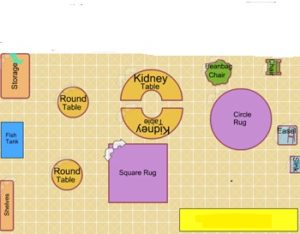Geometry II
 Simple maps be one of the best ways we can introduce children to and reinforce basic concepts of spatial thinking.
Simple maps be one of the best ways we can introduce children to and reinforce basic concepts of spatial thinking.
Imagine drawing a simple map of your sand table. On it, you indicate where certain small toys can be found (you have buried them there, previously). Children (I would suggest one at a time) can go over to the table and using the map unearth the hidden objects. Of course, children can simply dig around and find the objects, but if you design this activity specifically for the purpose of map use, the children will know that this is a game with a specific set of rules to follow.
You may have to help children under 4 orient the map so they can mentally imagine how the map lines up to the actual sand table. This mental rotation of objects in space is a fundamental geometric skill.
This activity can be repeated using simple maps of areas all over your center, classroom, and outdoor spaces. It works just like hide and seek except there is map, clues, and investigation involved. If you create some good ones, go ahead and get them laminated and then they can be used and reused over and over again, with dry erase markers.
Awesome! We have a raised garden with various vegetables. Plus, this will also allow the children to learn the vegetables names.
Interesting! A map of the garden with the names of the vegetables is an awesome idea. Thanks for sharing.
Loved mapping of the room using all the shapes found. Teaches the same shapes can come in different sizes. They can also make a graph of how many circles, triangles etc. are in the room.
Loved mapping of the room. Children can recognize the shapes found in the room.Make a graph of the room- how many circles, squares etc. can be found. Shapes do not have to be the same size to be the same.
Loved the map of the room. Children can learn shapes do not have to be the same size to be the same. Make a chart of how many circles, triangles etc. are found in the room.
Loved mapping of the room using all the shapes found. Teaches the same shapes
can come indifferent sizes. They can also make a graph of how may circles, triangles etc. are in the room.
Posted two replies already. Do I leave a third?